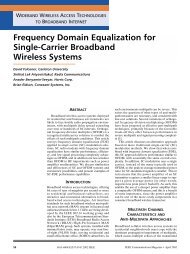Image Reconstruction for 3D Lung Imaging - Department of Systems ...
Image Reconstruction for 3D Lung Imaging - Department of Systems ...
Image Reconstruction for 3D Lung Imaging - Department of Systems ...
Create successful ePaper yourself
Turn your PDF publications into a flip-book with our unique Google optimized e-Paper software.
Substitution <strong>of</strong> 2.24 into 2.21 yields<br />
�<br />
[∇ · (vσ∇ũ) − σ∇ũ · ∇v]dΩ = 0 (2.25)<br />
Ω<br />
Rearranging gives<br />
�<br />
�<br />
∇ · (vσ∇ũ)dΩ =<br />
Ω<br />
Ω<br />
σ∇ũ · ∇vdΩ (2.26)<br />
Gauss’ Theorem is the older name <strong>for</strong> the Divergence theorem which is a mathematical<br />
statement <strong>of</strong> the physical fact that, in the absence <strong>of</strong> the creation or<br />
destruction <strong>of</strong> matter, the density within a region <strong>of</strong> space can change only by<br />
having it flow into or away from the region through its boundary. Gauss’ Theorem<br />
is valid in any dimension, however in 2D it is �<br />
∇ · FdV = �<br />
FdS where V is<br />
volume and S is surface area.<br />
Invoking Gauss’ Theorem on 2.26 permits the introduction <strong>of</strong> boundary conditions:<br />
�<br />
�<br />
vσ∇ũ · ˆndΓ = σ∇ũ · ∇vdΩ (2.27)<br />
∂Ω<br />
Ω<br />
Note that ∇φ · ˆn = ∂φ<br />
∂ˆn so 2.27 could also be written<br />
�<br />
�<br />
σ∇ũ · ∇vdΩ = vσ ∂ũ<br />
dΓ (2.28)<br />
∂ˆn<br />
Ω<br />
∂Ω<br />
The boundary integral only needs to be carried out <strong>for</strong> elements underneath electrodes. The<br />
left side <strong>of</strong> 2.28 is <strong>for</strong> the entire mesh. When examined <strong>for</strong> a single triangular 2D element,<br />
k, the left side is<br />
�<br />
σk∇ũ · ∇vdΩ (2.29)<br />
Ek<br />
Substituting the definitions <strong>of</strong> the interpolating versions <strong>of</strong> v and u yields<br />
�<br />
Ek<br />
σk∇<br />
3�<br />
uiφi · ∇<br />
i=1<br />
V<br />
3�<br />
wjũj dΩ (2.30)<br />
i=1<br />
If the conductivity, σk, is constant over a single element then the nodal voltages ui, the<br />
coefficients <strong>for</strong> the weighing functions, and the summations can be moved outside <strong>of</strong> the<br />
integral:<br />
3�<br />
3�<br />
�<br />
σk ui wj<br />
i=1 j=1<br />
Ek<br />
∇φi · ∇φj dΩ (2.31)<br />
It is common to break out the integral part <strong>of</strong> the equation as<br />
�<br />
S k ij =<br />
Ek<br />
∇φi · ∇φj dΩ (2.32)<br />
22<br />
∂V





